|
73. Coenonympha tullia (Müller, 1764) / Large heath / Nymphalidae – Satyrinae
NL: veenhooibeestje / D: Groβes Wiesenvögelchen, Grosser Heufalter / F: fadet des tourbières, le daphnis
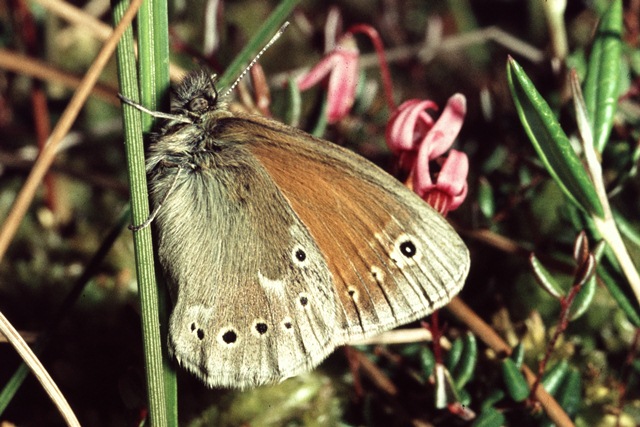 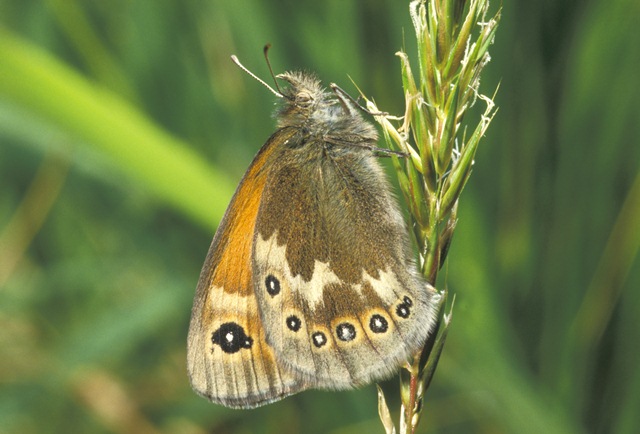
Photographs: Frits Bink ©.
Small or medium-sized, wing length 19 (17-21) mm. In the Benelux, known from heathland in marshy places and former peat cuttings. It is in decline in most parts of Europe.
Butterfly is on the wing from early-June until mid-July in the Netherlands and peaks late-June, in the Ardennes from early-June until late-August and peaks mid-July. The species is known from maritime and severe continental climates, required heat sum 300°d, maximum tolerated 800°d, corresponding climate windows 18 and 25 weeks.
The species inhabits fringes of raised bogs, taiga and boreal marshy grassland grazed by sheep. It is supposed to be one of the species suffering from climate warming.
However, in the marshes above 500 m altitude in the Ardennes the species has also disappeared. There are now only a few colonies in the lowland provinces of Drenthe and Friesland, Netherlands.
Ecological characteristics
Behaviour over time
Overwintering: half grown larva in third or fourth instar, 8-9 mm in length, hidden in a tussock of the host-plant.
Reproduction: oviposition starts after 3-5 days when the body contains 52 (35-63) eggs, estimated potential production 1.5 times as much. Female produces 10 (6-14) eggs per day.
Larval feeding periods: in summer and autumn 63 (41-86) days from mid-July until end-September, in next spring 34 (29-37) days from early-April until mid-July.
Generations: one, but in northern countries sometimes one generation over two years.
Spreading of risk: flexibility in larval hibernation.
Life cycle: egg 15 (13-18) days; larva 44-47 weeks; pupa 16 (9-23) days.
Life span of adult: short, 2 weeks.
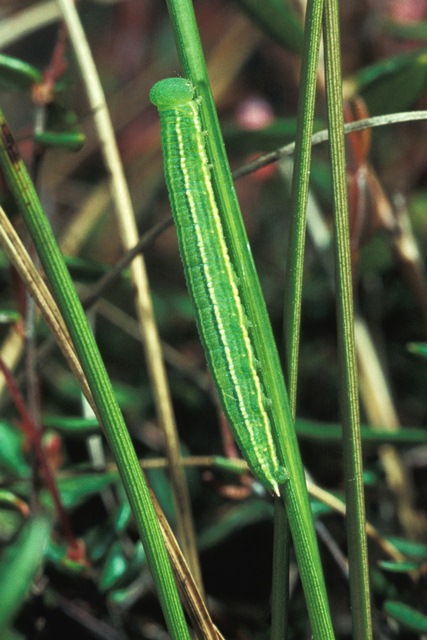 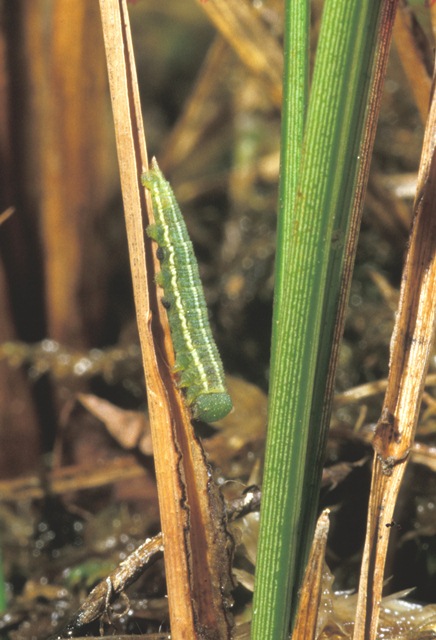
Photographs: Frits Bink ©.
Behaviour in space
From stay-at-home to migrant: stay-at-home, spatial requirement modest.
Finding a mate: male patrols.
Orientation in the landscape: fringes of wet ground.
Oviposition: female selects on type of vegetation consisting of a mixture of grasses and sedges.
Defence
Threats from other organisms: vulnerable, only concealment in larval stage.
Threats from the environment: vulnerable from heat and drought.
Feeding habits
Adult: little nectar feeding, known from cross-leaved-heather.
Larva: when young, larva accepts old leaves, in spring young shoots.
Larval foodplants
Plant species accepted in experiments: Cyperaceae, Carex diandra, C. rostrate, Eriophorum angustifolium, E. vaginatum, Poaceae, Danthonia decumbens,
Deschampsia cespitosa, Molinia caerulea.
Journal
Rearing experiments:
1. Based on specimens from Baraque de Fraiture, Bihain, Belgium:
2 August 1980: two females captured and laid eggs on Eriophorum angustifolium and Carex rostrata.
17 August: eggs had hatched. Biggest larvae in moult L1-2, larvae had eaten Eriophorum, Festuca and Molinia.
Overwintering larva about 6 mm in length hidden in peat moss layer.
Overwintered outdoors.
8 March 1981: larvae were active, selected Eriophorum.
1 April: larvae c. 8 mm in length hide by day.
12 April: larva, 26 mm in length ate Carex rostrata.
22 April: first larva pupated.
13 May: two pupae hatched, male and female.
31 May: last pupa hatched.
2. Based on specimens from Dwingeloo, Netherlands:
2 July 1985: three females captured.
3 July: eggs laid.
16 July: eggs hatched.
28 July: larvae in moult L1-2.
2 August: larvae ended second instar.
26 August: one larva very big, probably L4, others in moult. Eriophorum was preferred, four fed on Molinia, two larvae remained on dead stems, in diapause?
6 September: there were some larvae feeding, appeared to be in L4.
11 September: most larvae on wilted stems and appeared to be in diapause.
16 September: out of 22 larvae there were four in L4 about 10 mm in length. The bigger larvae were put on a tussock of Poa annua, which they appeared to accept.
24 September: larvae on Poa annua failed to grow and were transferred to Deschampsia cespitosa, which was successful.
Overwintered outdoors.
9 March 1986: larvae were active.
20 April: eight larvae, in fourth instar, had eaten a small bud, of Deschampsia cespitosa. Eriophorum started to grow.
27 April: larvae in moult L4-5.
8 May: biggest larva almost fully grown. Food preference: Deschampsia cespitosa, Eriophorum angustifolium and young shoots of Molinia caerulea.
10 May: 10 larvae end L5.
19 May: first larva pupated.
27 May: eight pupae observed.
29 May: first adult appeared, female.
31 May: two males hatched.
1 June: one female hatched.
2 June: copulation observed.
5 June: 12 eggs laid.
10 June: a total of 53 eggs laid.
15 June: last pupa hatched, female.
17 June: first eggs hatched.
6 July: larvae second instar, 5 mm in length.
9 August: three larvae in third instar, 9-10 mm in length, fed on Eriophorum.
23 August: one larva in moult L3-4.
19 September: no larvae seen for a week, all probably in diapause.
Table 73-1. Results of dissections

Table 73-2. Collection and observation localities
B, Baraque de Fraiture, 550 m, 50° 14’ 32”N – 5° 46’ 58”E; 2 August 1980.
DK, Tofte Mose 56° 50’39”- 10° 11’ 11”E; 5 July 2005.
DK, Rømø 55° 07’ 54”N – 8° 30’ 21”E; 12 June 2004.
EST, Valge raba 58° 26’ 29”N – 25° 14’ 09”E; 8 July 1999.
NL, Dwingeloo, Lange Veen 52° 48’ 58”N – 6° 25’ 44”E; 2 July 1985.
NL, Schoonloo, ven 61, 52° 54’ 24”N - 6° 40’ 01”E; 22 June 2005.
NL, Schoonloo, Hingsteveen 52° 55’ 15”N - 6° 35’ 57”E; 22 June 2005.
Fig. 73-1. Coenonympha tullia, phenogram adapted from Bos et al. 2006: 216 (dark part) & Fichefet et al. 2008: 203 (light part).
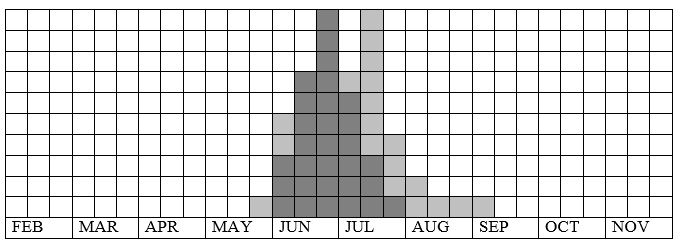
Fig. 73-2. Coenonympha tullia, habitat characteristics.
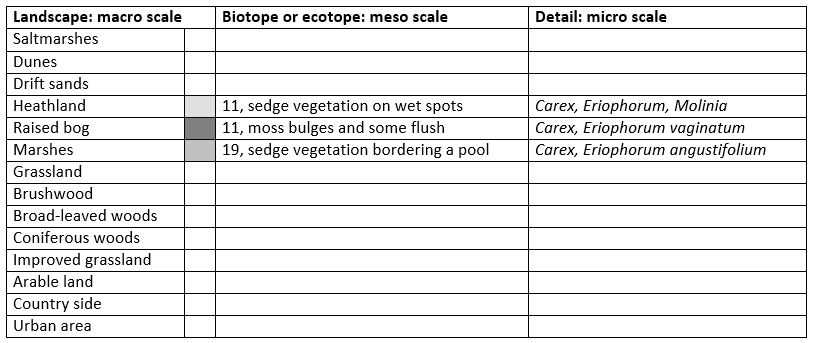
Fig. 73-3. Coenonympha tullia, climate matrix, heat-sums 300 - 800°d.
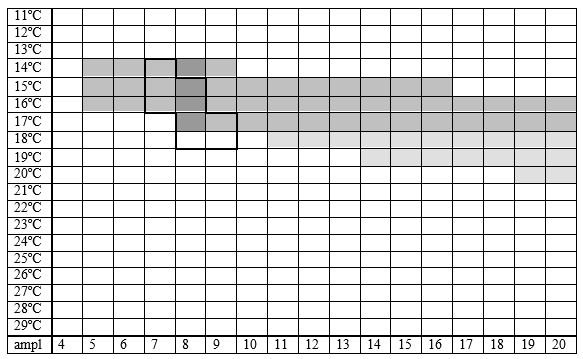
|









